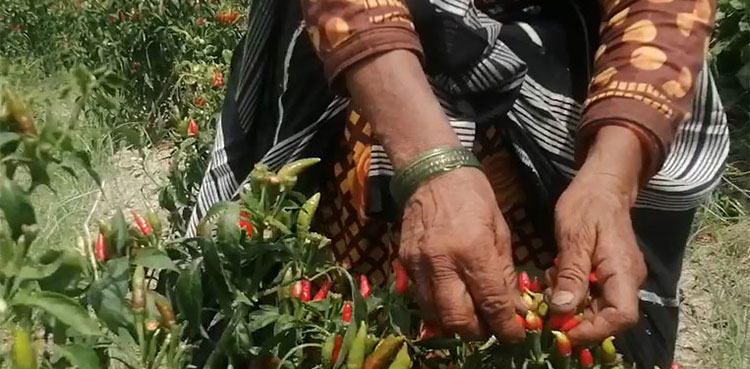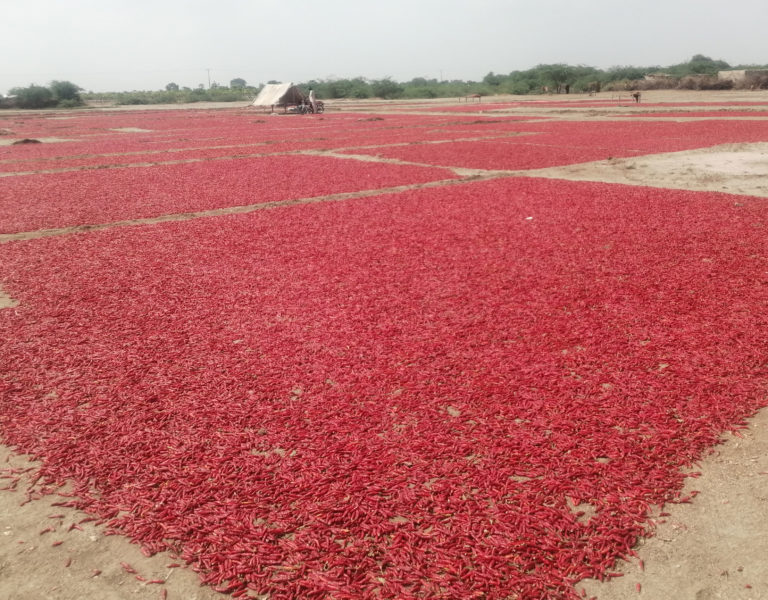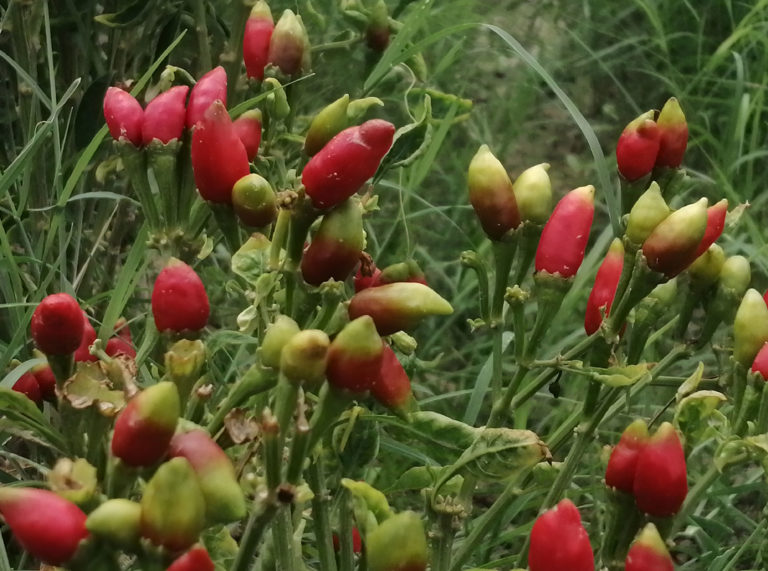
Shad Bibi, 28, is busy picking red chillies. Her young daughter sits beside her with her little brother cradled against her.
As he starts crying, Shad Bibi picks him up with dirty, peppered hands. The infant cries even louder apparently due to discomfort or burning feeling from contact with peppers. She, like many other women, is toiling in the chilli fields in Kunri, a town in Umerkot district in Sindh, without protective clothing, making herself vulnerable to various ailments caused by the exposure to peppers.
Skin, eye and respiratory problems are common among chilli farmers. Their children are not immune to these illnesses. Local residents also suffer during the peak season when the pungent smell of chillies wafts through the air.
Kunri is billed as Asia’s chilli capital. According to rough estimates, the area accounts for 85 per cent of Pakistan’s total annual red chilli production and contributes 1.5 per cent to the country’s GDP.
Harvesting of red chilli starts in August and reaches its peak during October. After harvesting, the yield is transported to Mirch Mandi (pepper market) for auctioning. This process continues well into January or February.
Chilli grown in and around Kunri is famed for its strong taste. Due to that taste, its demand and price are higher than that of the peppers cultivated in other parts of the country. But the cost that the workers who work in these chilli fields pay is much higher.
“Chilli picking and handling takes heavy health toll on labourers,” said Wajid Leghari, a social worker.
“Women make up the bulk of chilli harvesters. They suffer from various health problems. Complaints of skin and eye irritation, redness, burning sensations on hands and face, bruises, cough and sore throat are common among them.”
“They also bring their children, including very young babies, along with them to the fields, leaving them exposed to peppers.”

Mirch Mandi
Mirch Mandi lies in the heart of Kunri. “The town was sparsely populated when the mandi was set up four decades ago, but it ended up in the middle of the city as the population grew over time,” Leghari said.
He said as chillies are left under the sun to dry up at the mandi their strong smell permeates the air in every direction, taking a toll on the residents’ health.
“When the season is at its peak, the pungent smell of chillies is so severe that shopkeepers nearby are compelled to keep their shops shut and residents have difficulty breathing. Not only the areas surrounding the mandi but the entire city suffers from various issues.”
No eye or skin specialist
Dr Mubarak Ali Dars, medical superintendent of the Taluka Kunri Hospital, said that the chilli picking season sees a rise in various diseases across the city. Especially, the people residing in close proximity to the mandi have to face difficulties, he added.
“The harvesting season adds to the suffering of the elderly, children and the people having breathing issues. The number of patients with complaints of respiratory issues, cough and burning sensations increases.”
“The people associated with the pepper business frequent the city’s sole government-run health facility with skin ailments,” he maintained.
He said that children are also afflicted with similar health issues and those with weak immunity are at risk of severe diseases.
Dr Mubarak said that there is only one chest specialist at the hospital for the entire population of the city and there is no eye or skin specialist in the area. He said that the patients visiting the health facility are urged to use safety gadgets, like face masks and gloves, while working in chilli fields or handling peppers but they adhere to these precautions for a day or two and then put them aside.

New mandi
Azeem Memon, a chilli trader and resident of Kunri, said that in 2007, the government had given approval for the establishment of a new mandi outside the city to address the issue and released funds for the purpose. Though the construction work started shortly after the approval, it could not be completed despite the lapse of fourteen years, he lamented.
He said that the initial cost of the project was estimated at Rs160 million and the funds were released immediately but fell prey to corruption. “More funds were released later but that too ended up in pockets,” he said, recalling that in 2017, the National Accountability Bureau (NAB) had taken notice of alleged corruption in the construction of the mandi and investigated the officials concerned.
“Over the past 14 years, Rs600 to 700 million are said to have been released yet the mandi could not see the light of the day, nor it is likely to do in the foreseeable future,” Memon said, adding some of the shops built with the use of sub-standard material have already fallen into disrepair. The relocation of the mandi outside the city would definitely remedy the problem, he opined.
To Read This Article in Urdu, Click Here
from ARY NEWS https://ift.tt/97WYlIb
via

0 Comments